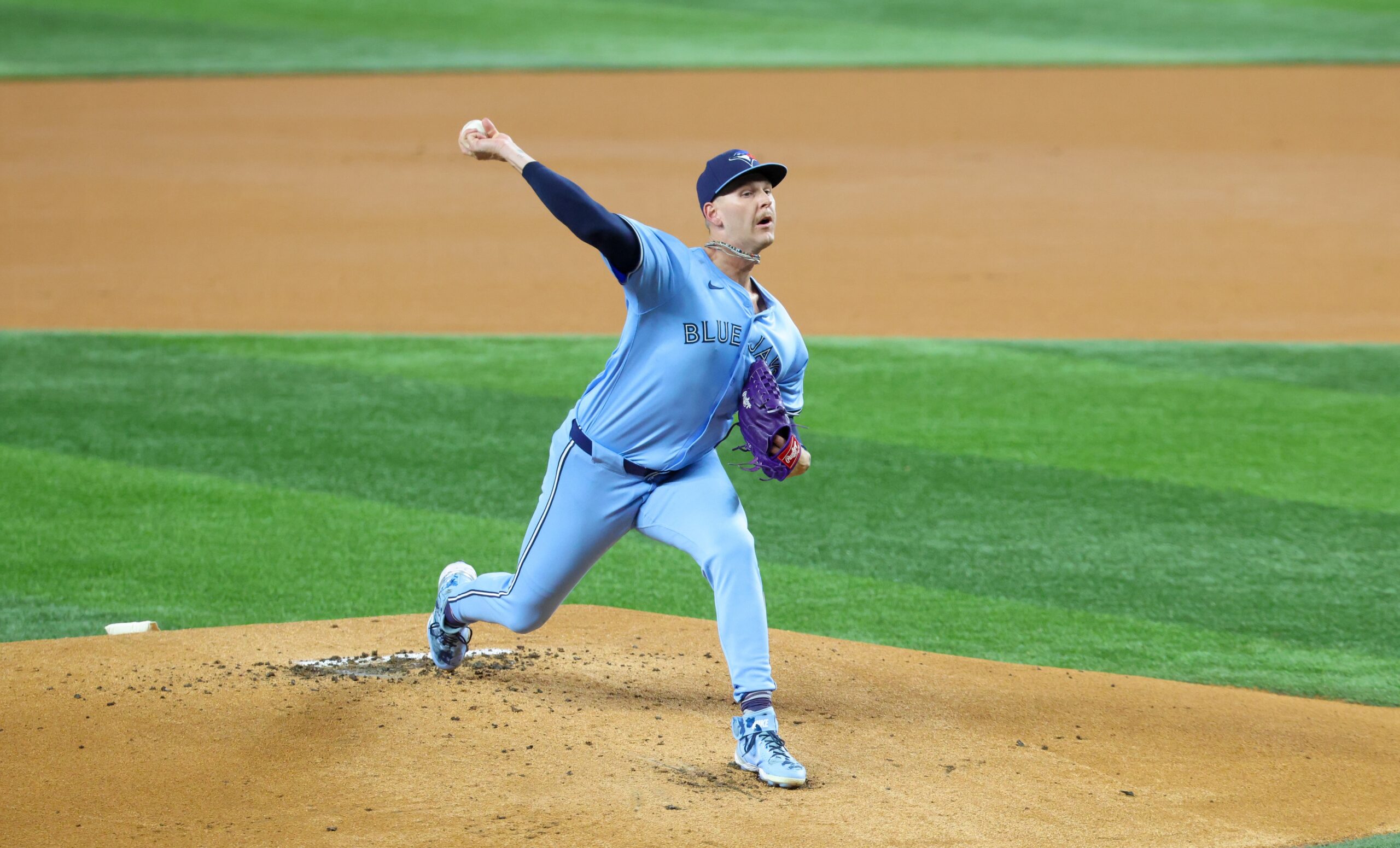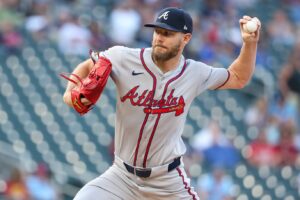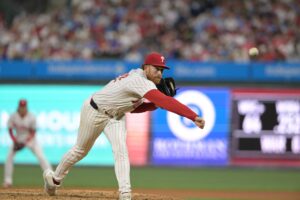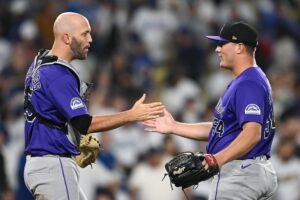Bowden Francis of the Toronto Blue Jays has put together a sensational second half of the season, leading to a new level of dominance in recent weeks. His 1.95 ERA across 60 innings since the All-Star break ranks in the top five among qualified starters. He has endured some rocky moments early in the season in his first full year as a starting pitcher. Francis made the Opening Day rotation for Toronto, then went on to have real struggles, posting a 5.82 ERA through the All-Star break. The struggles came along with a forearm injury that sidelined him for some time. However, after returning from the bullpen into the rotation following the trade of Yusei Kikuchi, Francis has vaulted to a new level through some usage changes as well as some good fortune.
Behind Bowden Francis’ Recent Stretch of Dominance
Pitch Usage
1st Half
In the first half of the season, Francis relied heavily on his four-seam fastball to both lefty and righty hitters, throwing it over 50% of the time. This extreme usage came despite his fastball grading out as roughly an average pitch according to Stuff+, which only looks at the physical characteristics of a pitch. The pitch did get an above-average amount of vertical ride of 18.3 inches of induced vertical break (iVB) although Francis threw it at a below-average velocity.
The results versus right-handed hitters in particular were not good, as he allowed a .914 OPS against them compared to a .709 OPS against left-handed hitters. Specifically, opposing hitters feasted on his fastball, with a .421 xwOBA. On the other hand, the curveball was getting hit for damage versus left-handed hitters to the tune of a .479 xwOBA. Here is how Francis’ pitch usage shook out in the first half of the season against each handedness of hitter.
Pitch Usage vs. Right-Handed Hitters
| Four-Seam Fastball | 52.7% |
| Curveball | 33.2% |
| Slider | 10.5% |
| Splitter | 3.3% |
Pitch Usage vs. Left-Handed Hitters
| Four-Seam Fastball | 54.1% |
| Curveball | 23.4% |
| Slider | 1.2% |
| Splitter | 21% |
2nd Half
Referring back to Stuff+, Francis’ best pitch by the model is his splitter, grading out at a 109 for the season. Stuff+ is scaled to where 100 represents an average pitch. He threw this pitch roughly 20% of the time versus left-handed hitters, but could likely push that number up given its quality. One of the more rudimentary ways for a pitcher to improve in season is by simply throwing their best pitches more often. In the second half of the season, that is precisely what Francis did. Here are the usage tweaks that Francis made in the second half of the season which led to the exemplary results.
Pitch Usage vs. Right-Handed Hitters
| Four-Seam Fastball | 48.4% |
| Curveball | 7.8% |
| Slider | 20.9% |
| Splitter | 14.6% |
| Sinker | 8.3% |
Pitch Usage vs. Left-Handed Hitters
| Four-Seam Fastball | 51.1% |
| Curveball | 12.6% |
| Splitter | 35.2% |
| Slider | 0.8% |
The primary observable change is the significant uptick in splitter usage against both lefties and righties. The reliance on his four-seam fastball remained similar, but the interaction effect of the increase in splitter usage compounded with a much better outcome. The high-rise fastball paired with the tumble and fade of the splitter creates a devastating tunnel. He has consistently displayed the ability to command this pitch to both sides of hitter. The expected damage on his four-seam fastball to right-handed hitters improved from a poor .421 xwOBA in the first half to an elite .180 xwOBA in the second half. That in part with other improvements had an extreme flip on his .914 OPS split against righties from the first half to an obscene .397 OPS. That is an obviously unsustainable number, but still remarkable.
Bowden Francis, Filthy 85mph Splitter…and Sword. ⚔️ pic.twitter.com/wBH9uqRvDI
— Rob Friedman (@PitchingNinja) September 11, 2024
Good Fortune?
Tied in with Francis’ change in pitch usage was better performance in commanding the zone and limiting walks. His 3.2% walk rate in the second half is third best only behind the command artists of the Seattle Mariners, Bryan Woo and George Kirby. The increase in splitter usage, in addition to other minor adjustments, allowed Francis to be one of the most effective starters in the second half. While his strikeout rate did improve, the underlying metrics do not reveal a significant change as his swinging strike rate rose from 10% to just 11.8% in the second half.
Any stretch that includes conceding just 16 hits over a 48-inning span is bound to include a good amount of luck. In fact, his Batting Average on Balls in Play (BABIP) has reached historic levels.
I’m a huge fan of what we’ve seen from Bowden Francis.
He’s also got the lowest 2nd-half BABIP (min 50 IP) in post-war history. By a LOT. https://t.co/DOC14gNocP
So, maybe keep that one in mind headed into next year. pic.twitter.com/0VU1IXsCiS
— Mike Petriello (@mike_petriello) September 17, 2024
As Mike Petriello points out, Francis has one of the lowest BABIPs over this number of innings in a long time. This is something that will undoubtedly correct itself, as the average BABIP is always near .300. Some pitchers certainly have the profile that lends them to produce lower BABIPs, and Francis could fit the bill, but it is to be determined.
Chasing History
Bowden Francis accomplished something amidst the aforementioned 16 hits in 48 innings stretch that has not been seen in a while. In a start at home against the Angels on August 24th, Francis had a no-hitter going into the 9th inning only to lose it on a home run to the first batter he faced. Flash forward a few weeks to September 11th, Francis faced the exact same situation. Surely enough, the same result occurred with a first at-bat home run.
pitchers with 2 no-hit bids lost in the 9th in a season on record:
2024 Bowden Francis
1989 Nolan Ryan
1988 Dave Stieb
1906 Ed Walsh— Sarah Langs (@SlangsOnSports) September 11, 2024
Bowden Francis came three outs away from a no-hitter twice in a span of 18 days, and with this recent stretch of dominance, he has established himself as an integral piece of the Toronto rotation heading into next season.
Photo Credit: © Kevin Jairaj-Imagn Images






